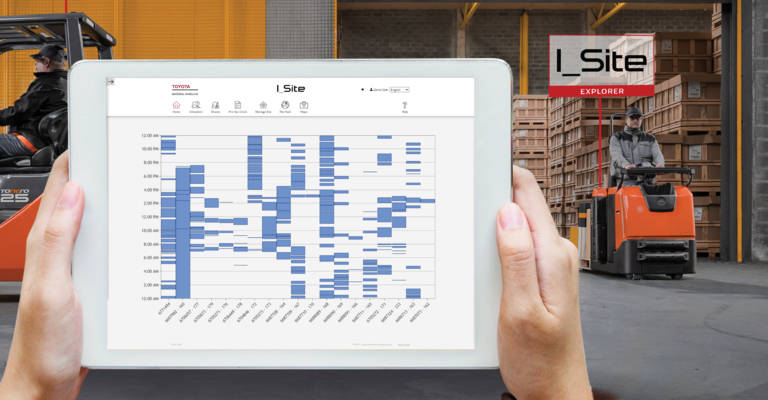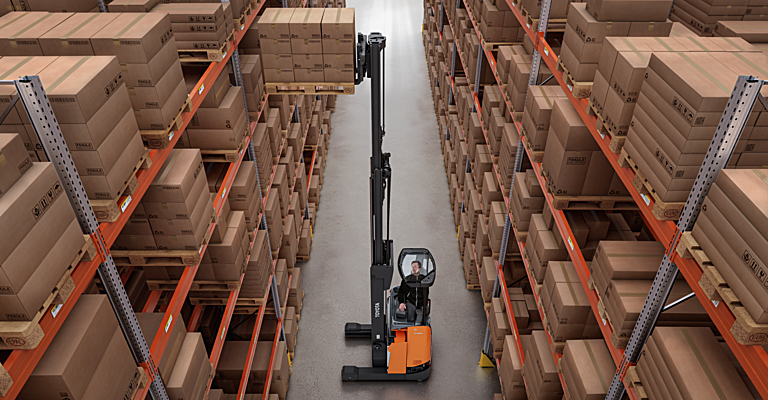Trucks with lithium-ion batteries have many benefits: they have a high energy density, are very efficient, they have no emissions if green electricity is used, they don’t need service and have a much longer lifespan, but most of all; they are the ideal energy solution for opportunity charging. Opportunity charging means you can charge your trucks any time when they are not in use, even during your fifteen-minute break. This type of in-shift charging means that unlike with lead-acid batteries, you don’t need to replace your Li-ion battery. If you want to shift to Li-ion, there are many ways to organise your operation around opportunity charging. We’ll start you off with some tips.
Find out when your trucks are not in use
Let’s take a look at when and how often your trucks are being used. Calculating your utilisation rate is much easier with connected trucks; just look at your fleet management data on the I_Site tool, which shows data taken from your connected smart trucks. Experience tells us that warehouse trucks are often not actively in use for over 50% of a shift. Meaning there is a lot of room left to opportunity charge your inactive trucks during working hours. Using I_Site and connected trucks, you can easily check each truck’s charging time. This way your drivers never have to worry about a near-empty battery ever again.

Take a look at your warehouse layout
Our chargers only need a reliable electricity supply to power up your equipment, which means they are relatively flexible in terms of where you want to install them. So let’s take a closer look at your site’s floor plan; think your chargers need to be close to your canteen area? We’ll assure you that is not necessary. You can install your chargers near the area where your operators leave their trucks. This is one of the many benefits of Li-ion as compared to lead-acid: you don’t need a separate charging room since chargers can be placed anywhere on your site. Making your warehouse more flexible and freeing up some space. We’ll give you some tips on where to place your chargers:
- Look at your warehouse flow: What trucks are you using, at what time and where are you using them? Discovering when, where and for how long your trucks are being used, will help you define the best spots to put your chargers.
- Check safety aspects and legislation in your country: there might be some rules or laws you have to abide. In some countries, you can’t put a charger within a 2,5-metre perimeter of paper or burning substances. If this condition can’t be met, you can add a metal plate on top of your charger. Always push the stop button before disconnecting your charger.
- Identify truck parking places: where do you have the space to park your trucks and where do they naturally stand still? These places are great to install chargers. You can create proper truck parking spots or install a warehouse policy stating where you can or cannot park.
- Convert your vacant old lead-acid battery charging room: you can use this area to install Li-ion chargers. Of course, Li-ion batteries don’t need a separate room for charging but if you have a spare room, why not use it?
- Don’t hesitate to contact us: Our dedicated sales team can help you identify the right charging points, adapted to your operation, to ensure a lean flow.

Prevent power peaks
If you decide to opportunity charge all your trucks at once, for example, during lunch hours, it might cause power peaks, pushing your electricity bill up. That’s why all of our external smart chargers come with Dynamic Power Limitations (DPL) to reduce your costs. In many countries, the electricity rate is based on usage peaks. So the key to reducing your bill is controlling these peaks. DPL works with smart chargers and makes sure that when you are charging several trucks at the same time, the truck with the least battery charge left will receive more power. This makes it super easy to manage your electricity peaks and reduce costs.
Keep your battery happy by creating good charging habits
Li-ion batteries have a lot of benefits for operations that have good charging habits. If your operators make a habit of charging their truck while they are not using it, you’ll keep your trucks up and running, ensuring maximum productivity.
When looking at our I_Site data for the BT Reflex RRE160H, we see that the average lifespan of a lead-acid battery is shortened by 30% due to faulty charging habits (average based on data from 5000 trucks). The batteries are being charged whilst still having some battery capacity left, which reduces the overall lifespan of lead-acid batteries. With Li-ion batteries, opportunity charging does not have an impact on the batteries’ lifecycle and you don’t have to worry about leftover charge or overcharging. So your drivers can charge their trucks when they actually have time to do so.
Often when looking at timeslots to opportunity charge equipment, we look at breaktimes. But your trucks do not have to be fed while you’re eating. Your drivers can also charge their truck when they are not using it. It depends on the intensity of the shift and on what is easier for your staff. Help your drivers create a good opportunity charging schedule and make plugging in trucks when away a habit. When switching from lead-acid to lithium-ion, opportunity charging will help you to keep your productivity high and your costs low.

.jpg)




